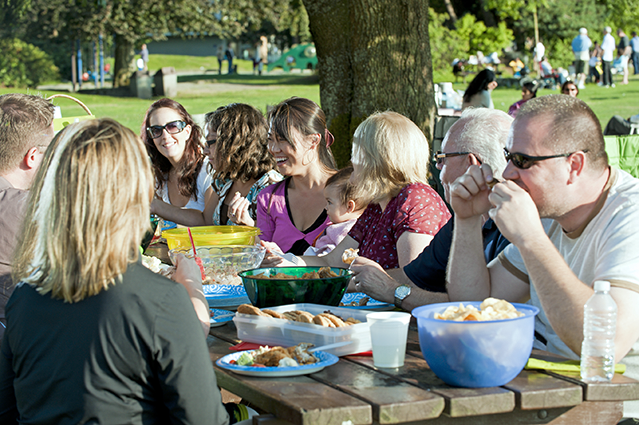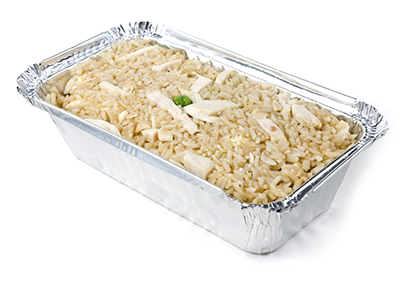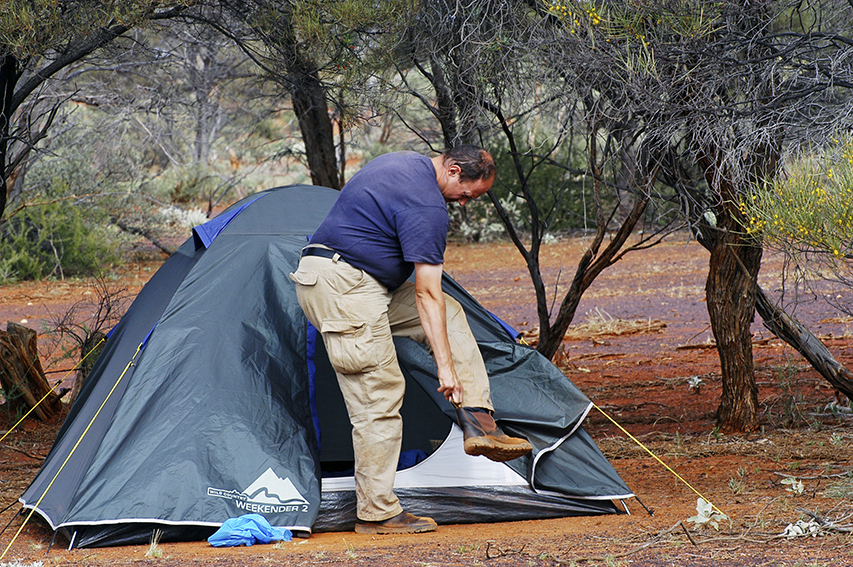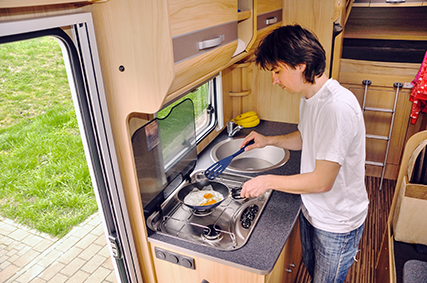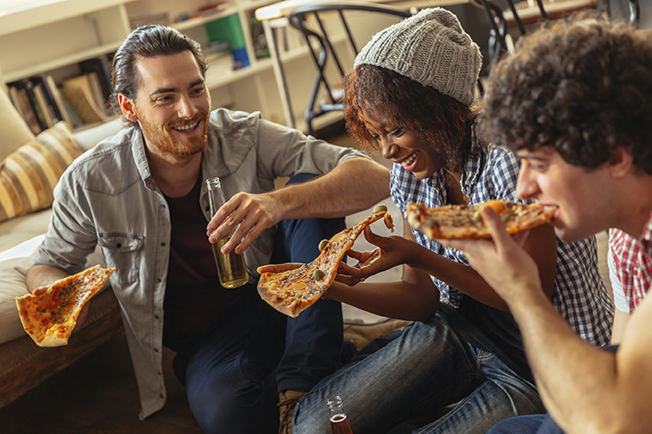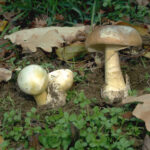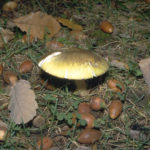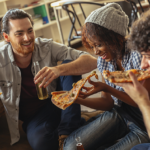Food safety on the move
Eating outdoors: BBQs and picnics
Eating outdoors is a great way to make the best of Australia’s great climate. But eating outdoors increases the risk of food poisoning for a number of reasons. For example, your food will be stored in a cooler such as an esky. This makes it much more difficult to maintain a safe food storage temperature of 5°C or below.
Follow these tips to make sure your fun day out doesn’t turn into a nightmare
Chill
- Remember the simple rule for food safety; keep hot foods hot and cold foods cold. Put all perishable foods in a cooler when travelling.
- Don’t pack food for a picnic if it has just been cooked and is still warm. Coolers cannot cool food enough to prevent bacteria growing. Always cover pre-prepared foods securely and keep in the refrigerator overnight. Other perishable foods and drinks, such as deli products, cooked chicken and dairy products must also be cold when put in the cooler.
- Always pack plenty of frozen bricks or gel packs around the food. Frozen drinks thaw quickly in warm weather and serve as extra cool bricks. Wicker baskets, unless they are insulated, are best used for non-perishables and your other picnic needs.
- Avoid keeping perishables such as salads, quiches and cold meats out of the fridge for longer than 4 hours before eating. If you expect to return leftovers to the fridge they should be left out for no more than 2 hours.
Watch our short video about how to stack a cooler
Separate
- Meat juices can easily leak onto pre-prepared foods, so pack with this in mind and put the meat in leak proof containers on the bottom of the cooler away from ready-to-eat food.
- Cut meat into serving-size pieces before leaving home and have all salads ready to eat. This reduces the need to handle foods, particularly when there are no hand-washing facilities.
- Use a clean plate and clean utensils for cooked meat. Never re-use the same ones you used for the raw meat without washing them.
Clean
- Carry disposable wipes or alcohol based hand gel in case there is no water for hand washing.
- Don’t put food directly on picnic tables as they are not always clean so use clean plates or trays.
Cook
- Remember sausages, hamburgers and poultry need to be cooked all the way through – use a meat thermometer to check they have reached 75°C in the centre. Intact steaks and whole pieces of red meat can be cooked to taste.
- It’s all right to leave cooked meat to remain warm on a corner of the BBQ or covered on a plate for late arrivals. Just ensure it is protected from flies and, as with cold perishables, avoid leaving it around for more than four hours, (or two hours if there are leftovers to be put into the fridge).
Watch our short video about how to BBQ safely
Additional tips for BBQs at home
- Keep your meat in the fridge until you are ready to put it on the BBQ and keep all ready to eat food covered until you are ready to eat it. This will protect it from contamination by flies.
- Keep salads, patés, spreads, dips and other perishable products in the fridge until needed. It may seem like a great idea to leave food out so that guests can nibble throughout the whole day, but unfortunately bacteria will also have a feast. It’s better to divide these higher risk perishable foods into small amounts and replenish with fresh portions as required.
- It is even more important than indoor events that you don’t mix fresh top-ups with ones that have been outside for some time where they may also have been enjoyed by flies. Low risk foods, such as nuts, crisps, crackers can be topped up.
Eating out: Food safety in restaurants, cafés and take-aways
Strict food hygiene rules are in place for food retailers that are enforced by state and territory and local governments. These include having properly trained staff, clean premises and equipment, keeping food at the correct temperature and correct hand washing procedures.
If you answer ‘no’ to any of the questions below it could signal that the operators are not handling foods appropriately and there may be potential food safety problems.
- Are foods that require refrigeration adequately refrigerated and cold to the touch?
- Are foods kept or served steaming hot?
- If you can see food being prepared, are precautions taken to prevent cross contamination of food?
- Are raw and cooked foods kept separate at all times during preparation and display?
- Do staff use tongs or gloves when handling food and do you see them use separate tongs for different foods?
- Is there a hand washing basin? Do staff wash their hands well with warm soapy water between tasks?
- Are the areas you can see clean and tidy? Food preparation, such as cutting up meat and preparing dishes for the salad bar, may take place in areas you can’t see. Dirty staff and conditions in public areas may be a clue that things are worse behind the scenes.
All cooked food that has not been chilled, such as food in hot food cabinets (bain-maries), takeaway and home-delivered food, should be kept steaming hot. Chilled food should be displayed in correctly operating refrigerated cabinets or on ice.
Certain foods, such as minced meat, sausages, hamburger patties, rolled or stuffed roasts, and poultry must be cooked right through. There should be no pink meat and juices should run clear. If you have to send undercooked product back, always ask for fresh accompaniments such as vegetables, as juices from the undercooked products could have contaminated these. Steaks, chops and whole roasts can be cooked to your preference. Steak tartare, rare hamburgers and carpaccio may be fashionable, but they are also very high risk!
Self-service and salad bars
Self-service salad/dessert bars in restaurants can be popular but there are some food safety issues to keep in mind.
Hot food should ideally be served steaming hot, in hot food displays or over burners. However, in a buffet situation short periods of time at room temperature are acceptable. Chilled food should be kept chilled, either in refrigerated cabinets or on ice. Once again short periods at room temperature are acceptable.
Fresh food should be brought out regularly, and it should not be combined with the leftovers from the food being replaced. Each salad or dessert should have its own utensil. Use the one that is allocated to the item and don’t mix the serving utensils. Hold the utensils by the handle and, when replacing, ensure that the handle does not come into contact with the food.
Never touch or taste food on display. If you see anyone doing this, report it to a staff member. Food should be protected from coughs and sneezes by a guard – usually a clear plastic cover extending over the food.
Buying lunch
Pre-made sandwiches and rolls containing perishable ingredients, such as soft cheeses and meats, should preferably be stored under refrigeration, or otherwise at cooler room temperatures for no more than about four hours. Do not buy ‘tired-looking’ products, as they may have been at room temperature for too long.
Food in hot display cabinets should be steaming hot. Avoid purchasing food that is stacked too high in hot display cabinets. Return lukewarm pies and other filled products to the shop. Minced meats, such as hamburgers and sausages, and chickens should be cooked right through. Food from take-away outlets should be eaten within a few hours.
If you are not happy with the food safety aspects of a supermarket, restaurant or takeaway, do not return. Explain clearly to the management the reasons why you are not happy and contact your state and territory health department or local council.
Work and school lunch safety
Packing a lunch for yourself or your child is a healthy and cost effective option however food poisoning bacteria can grow quickly, especially in hot weather and in the healthier foods such as salad and cold meat we pack for lunch these days.
Choose
- Choose low risk foods such as hard cheeses, freshly cooked meats and poultry, fresh, well-washed fruits and vegetables, canned tuna or salmon, shelf stable snacks and sandwich spreads.
- When buying lunchboxes choose ones which are easy to clean and dry. Insulated lunchboxes are a great idea, but not if they are difficult to keep clean.
Clean
- When preparing food, always practice scrupulous handwashing.
- Lunchboxes and reusable drink bottles must be thoroughly washed and dried daily. If cracked, split or crazed, replace as bugs love hidey holes.
- Ensure cutting boards, benches and utensils are clean and dry.
- Wash all fruits and vegetables thoroughly.
- With a staff kitchen, set up a roster to ensure bench tops are clean and dish cloths, sponges, brushes and tea towels are clean and replaced regularly. Wash dirty dishes in hot soapy water or put in the dishwasher.
Cook
- Make sure lunch foods are cooked properly in the first place.
- When reheating, make sure they are steaming hot all the way through – stir or turn food as appropriate.
Chill
- Lunches can safely be prepared a little ahead of time provided they are kept in the fridge or frozen.
- When leaving home, pack a frozen juice box, water bottle or commercial ice pack with the lunch. Place perishable foods such as cheeses and sandwiches between the frozen items.
- Lunchboxes kept inside the school bag will keep cooler longer especially if the bag is away from heat sources such as direct sunlight.
- Divide cooked leftovers into small lunch-sized portions so they refrigerate or freeze quickly.
- Put food in the fridge as soon as you get to work or, if working on construction sites, outdoors or other environments with limited access to refrigerators, pack food in insulated containers with frozen drinks or freezer bricks and place the container in a cool place between meal breaks.
- Staff fridges should be uncrowded and running at or below 5°C. Provide labels and a pen so people can label and date any food they put in the fridge.
Separate
- Make sure lunchbox foods have been well separated from other foods in the refrigerator, particularly meats, chicken and fish, the juices of which will contaminate foods which won’t be cooked before adding to the lunchbox, such as fruits.
General advice
- If in doubt throw it out!
- Warn children against sharing drink bottles. Sharing lunches is also not a good idea as it is difficult to know what allergies other children may have, or whether the foods have been prepared using the basic food safety tips.
- If you or your child has food poisoning don’t go to work or school, and avoid handling food for others for 48 hours after symptoms such as vomiting and diarrhoea stop. If food poisoning symptoms persist, visit a doctor.
See also NSW Food Authority Lunch Box study
Camping and bushwalking
Food poisoning is no fun at the best of times, but it can be a major problem if you are camping or bushwalking and away from the convenience of toilets, hand basins and medical help. It is more prevalent in warm weather but can happen at any time of the year. Prevention is always better than cure and you can minimise the risk of getting food poisoning by being especially cautious about choosing the food you bring along, storing it at the correct temperature and being particular about how you handle it.
Choosing food to bring with you
The foods you choose for your camping or bush walking trip will depend on the type of food storage you have available, how much you can carry and whether safe water is available to add to foods.
Recommended foods:
- Dry, UHT and canned products. Bush walkers usually rely on dried or freeze-dried foods which are safe and have the advantage of low weight and bulk. If you are bush walking, pack your dried foods so they won’t get wet if it rains.
- Canned food is safe to keep at room temperature but it tends to be too heavy to carry in any quantity when bush walking.
- Hard cheeses can be taken without refrigeration, or in an insulated cooler, but avoid taking fresh, unmatured soft cheeses unless you have access to refrigeration.
- Fresh fruit and vegetables can be taken, but in warm weather some will deteriorate quickly so you may need some extra dried or canned varieties for later use. Most foods in cans or jars cannot be stored out of refrigeration once opened. Make sure that you buy containers small enough so that all the food is used up in one meal.
Foods you can safely take with you
|
Dried foods |
Canned and packaged foods |
Other foods (limited shelf life) |
| Rice | Canned vegetables & fruit | Bread |
| Pasta | Canned or packet soups | Cake |
| Powdered milk | Canned or packet meals | Fresh fruit |
| Dried fruit and vegetables | Baked and other canned beans | Fresh vegetables |
| Nuts | Spaghetti | Eggs |
| Breakfast cereals | Pasta and other sauces | Butter and margarine |
| Biscuits/crackers | Pickles and relishes | Hard cheese |
| Freeze dried foods | Canned meats and spreads | |
| Instant noodles | Canned fish | |
| Flour | Honey and jam | |
| Fruit bars | Long life milk, cream and custard | |
| Tea, coffee and other powdered drinks | Long life stocks and soups | |
| Custard powder | Long life fruit juices | |
| Packet meals | Processed cheese | |
| Confectionary | ||
| Stock cubes, herbs and spices | ||
| Tubes of condensed milk | ||
| Jerky and other dried meats |
Extra precautions:
- Perishable foods such as raw and cooked meats, poultry, chilled ready to eat foods, dairy foods and cooked eggs are generally unsuitable for camping holidays unless you have access to a refrigerator. If you have a cooler that depends on ice or ice bricks for cooling, you should not keep such foods, for more than one day unless the cooler is able to hold the temperature of the food at or below 5 degrees Celsius.
- If you are relying on dried food, make sure that you have access to enough safe water to rehydrate any food that will not be thoroughly cooked before consumption. Remember, water, even in remote and pristine wilderness is not necessarily safe and can be contaminated by animal faeces and naturally occurring parasites like Giardia. Unless you are sure that the water is safe, you should boil all water for at least one minute (a little longer if you are at high altitudes), or disinfect it in some way before drinking it or using it in powdered drinks or other uncooked foods.
- Avoid creating leftovers: discard them unless you can store them at or below 5 °C until they are eaten.
- If you are going bush walking overnight, you can take a frozen pre-prepared meal (eg stew or casserole) or frozen raw meat for cooking, provided that you eat it on the first night. Package the raw meat well so that the juices do not contaminate the rest of your food and bury the package deep in your backpack for extra insulation. Cook or reheat well.
- Always defrost any frozen food in a cooler or refrigerator when camping.
Using coolers and eskies
- Insulation properties and ease of cleaning are the two most important factors in choosing a cooler.
- Don’t pack food if it has just been cooked or is still warm. Coolers cannot cool food enough to prevent bacteria growing.
- Meat and chicken juices can easily leak onto other food in a cooler – make sure you package any raw meat and chicken in leak proof containers and place them on the bottom of the cooler and away from ready to eat food.
- To keep foods cool use freezer bricks, frozen gel packs or containers with frozen water (a brine solution of 5 parts water to one part of salt freezes at a lower temperature than water). Many campgrounds have fridges in camp kitchens where you can refreeze bricks and gel packs. Do not use loose ice unless foods are stored in water proof containers. This will prevent ice contaminating foods in the cooler as well as wetting the food. Periodically you should pour out the water formed and replace it with fresh ice.
- Pack as much as you can in the frozen state – e.g. milk, juices etc. These will help keep the other foods cool but remember, unless you have refrigeration they will need to be eaten as they thaw out.
- Organise your food in the cooler to limit the times the cooler is opened. Consider using separate coolers for food and drinks if the cooler will constantly be opened for drinks.
- If possible, fill any excess space in your cooler with frozen drinking water. The fuller the cooler, the longer it will hold its temperature.
- When you have chosen your camping site, get your cooler out of the car into the shade as soon as possible. Keep it out of the sun. Take a hint from our ancestors and cover the cooler with a wet-bag to promote evaporative cooling.
Car fridges and electric coolers
Portable fridges and electric coolers are also now available and may be useful if you are travelling by car. A ‘Choice’ magazine study of portable fridges found that, in some models, setting the temperature and maintaining it was difficult when the environment temperature changed. Food could, therefore, freeze or become too warm.
- Electric coolers are not refrigerators and have a limited cooling capability (usually about 30 degrees C below the environment temperature). Therefore, they can only be used for short periods of storage in hot weather.
- It’s a good idea to have a fridge thermometer in your cooler or portable fridge to check on the temperature.
- Make sure the power supply is constant. When camping, you might need to find an alternate power supply so your car battery isn’t drained.
Cooking and reheating
- Always cook chicken, stuffed meats, sausages, liver and minced meat such as hamburger so that the juices run clear – there should be no hint of pink in the centre. Steaks, chops and whole pieces of meat can be cooked to preference.
- Use a clean plate and clean utensils for cooked meat. Never re-use the same ones you used for the raw meat without washing them.
- When reheating food, make sure that you heat it to steaming hot.
Drinking water and water for rehydrating food to be eaten without further cooking
Boil water vigorously for at least one minute (a little longer if you are at high altitudes). Boiling water is the most efficient method of disinfection, chemical methods may not kill some parasitic organisms (giardia amoeba, and cryptosporidium).
You can also use:
Chlorine and iodine water disinfection tablets purchased from pharmacies, camping and sports stores. Use in accordance with the manufacturers’ directions.
Tincture of iodine can be used by adding 5 drops of 2% Tincture of Iodine to 1 litre of clear water. If the water is cloudy, add 10 drops. Let the solution stand for 30minutes before drinking. If you know that parasites may be present in the area, allow the water to sit for 15 hours before drinking eg over night. If iodine-disinfected water is the only water available, it should only be used for a few weeks.
Portable water filters using reverse osmosis can be used but may be too large or expensive to take camping or hiking. Follow manufacturers’ instructions on appropriate use.
Camp Hygiene
- Keep utensils used for preparing raw foods well away from ready-to-eat foods. Wash them thoroughly in between use and remember to wash your hands prior to handling food.
- Always wash hands and dry them thoroughly after going to the toilet as it is just as important when you are camping as it is when you are at home. Use disposable wipes if necessary. Don’t forget to take this rubbish back out with you when you leave.
- Cover food and store food off the ground to protect it from insects, animals and dust.
- Keep your campsite clean. Birds and animals can be a source of food poisoning bacteria so don’t leave food, dirty utensils, food scraps and rubbish lying about to attract them. Food scraps and rubbish should be kept in a bin or bag that can be sealed. Keep utensils, cutlery and cooking equipment clean to help prevent birds and animal from being interested in your campsite.
- You need to dispose of rubbish and waste water carefully because they can attract pests and contaminate food and water. All rubbish should be but in bags and kept away from food. Tip wash-up and other waste water in any designated site or at least well away from water sources such as lakes and rivers.
List of Useful Food Safety Supplies for Car Camping and Backpacking
|
Food Safety Equipment |
Purpose |
| Cooler, Car fridge, Electric cooler, Esky, cooler bag | To keep perishable foods at a safe temperature |
| Fridge Thermometer | To check temperature of cooler, car fridge, electric cooler or esky if you are unsure if it is working properly |
| Food Storage Containers | To pack and store food safely preventing leakage and pests from accessing food |
| Disposable plates and utensils | If items can’t be washed in between uses |
| Disposable wipes or antibacterial hand gels | For use if water is not available for hand washing |
| Soap, dish washing detergent, paper towels | For washing and drying hands and food preparing equipment |
| Chlorine or iodine water disinfection tablets, tincture of iodine, or portable water filter | To disinfect water for drinking or for use in food preparation |
| Adequate rubbish bin/bags that can be sealed | To store food scraps and rubbish., preventing birds and animals from scavenging around camp site |
When choosing your site
| In remote locations – | In caravan parks and camping grounds – |
| Select a latrine site carefully, at least 50m from campsites and any water source. Bury waste a minimum of 300mm below the ground surface | Use the camper’s kitchen sink for cleaning food utensils and cutlery. Use hot water and bring a supply of detergent and a universal plug |
| Use disposable wipes or antibacterial hand gels or lotions to wash your hands if water is unavailable | Bring your own supply of soap, detergent, laundry powder and paper towels |
| Carry all rubbish until it can be disposed of at an appropriate location | Place all rubbish and waste food in bins |
Caravans and campers
Campervan and caravan food safety
If you are off on a campervan or caravan holiday you don’t want illness to spoil your fun think about how you are going to prepare food on the road. Follow the simple but effective hints suggested here and food poisoning won’t be an unwelcome hitchhiker on your road trip.
When you’re on the road in a motor-home, caravan or campervan, remember these important tips:
Clean
Our health is in our hands! Clean hands will decrease the possibility of food poisoning and other diseases markedly. Remember the 20/20 rule: wash hands for 20 seconds with warm soapy water dry hands for 20 seconds before starting to cook repeat frequently especially after handling raw meats, or vegetables with visible soil. Wash utensils and cutting boards with soap and warm water, and dry thoroughly, before handling different sorts of foods.This is particularly important when dealing with raw meats and vegetables.
Chill
Food that is meant to be kept chilled should be! As soon as possible after purchase meat, poultry, dairy foods, vegetables, salad ingredients, etc should be refrigerated at or below 5ºC. Sounds easy but often food is left in hot cars or put in refrigerators that are not cold enough. A fridge thermometer should be used to make sure the temperature is at or below 5ºC. The temperature should be adjusted in line with changing seasons and the amount stored. Refrigerate leftovers promptly. Cooked food should be stored in covered containers and either put in the fridge to cool, or frozen immediately. Frozen foods should be defrosted in the fridge NOT on the kitchen bench. If in doubt, throw it out!
Cook
Properly cooking food minimises the risk of food poisoning. Cook chicken, minced or boned meats, hamburger, stuffed meats and sausages right through until they reach 75°C. Serve hot food steaming hot above 60ºC. Defrost frozen poultry and rolled and stuffed meats thoroughly before cooking. Always follow cooking instructions on packaged foods.
Separate
Cross contamination is a major way for food borne diseases to spread. To avoid cross contamination keep raw and cooked foods separate when storing and preparing. Food should be stored in covered containers in the fridge and put raw meats and poultry in the bottom of the fridge so the juices don’t contaminate food on lower shelves. Don’t put cooked meat back on the plate the raw meat was on.
Your Travelling Kitchen
Cooking in caravans, motor-homes, or campervans is not always easy. The bench space is usually limited, there is probably less equipment, fridge space is small and a good supply of fresh running water is not always available.
Here are some tips to help cope with all of this:
- If water is going to be in short supply buy extra chopping boards, knives and other food preparation equipment or by ready chopped or prepared food.
- Take extra care to clean benchtops and utensils before, during and after food preparation.
- Carry lots of leak-proof containers with you and use them for any raw food to prevent leaks onto other foods. Zip lock plastic bags can also do the job, provided they are properly sealed and have no holes.
- Buy fresh – shopping from the local markets is a great way to get to know the small towns. You can also sample the fresh local produce.
Keeping food out of the temperature danger zone
The temperature danger zone where bacteria can grow quickly in food is between 5°C and 65°C. To reduce your risk of food poisoning:
- Keep a thermometer in the fridge to allow you to monitor and adjust the temperature when needed. If the temperature inside the fridge rises above 5°C, bacteria in the food can multiply and make the food unsafe to eat.
- Don’t overload the fridge and block air circulation which is needed to maintain the correct temperature.
- Take the beer, jam and pickles out of the fridge if you’re short of space. They are unlikely to cause food poisoning if they stay outside the fridge.
- Take special care when preparing cooked food for eating later and storing in the fridge. Make sure that all work surfaces and utensils used are clean. Refrigerate or freeze the food as soon as it stops steaming.
- If perishable food or leftovers have been out of the fridge for more than 2 hours throw it out.
- Freeze food in small containers or sealed bags containing only enough for one meal to reduce left-overs. Remember to label and date the packages.
- Thaw food in a microwave or in the fridge – never on the benchtop. Soups and stews can be heated from frozen in a saucepan. Whatever way you thaw the food, make sure that it is heated to steaming hot above 65°C before it is eaten.
- Minimise contamination by always storing raw meats and poultry on the lowest shelf of the fridge, below ready to eat fresh food. This will prevent contaminated juices dripping from the raw meat onto foods you will not be cooking again before eating, such as salads or desserts.
Don’t forget to take a cooking thermometer as well to make sure minced meat and poultry are cooked to above 75°C and hot food served above 60°C.
Canned and dry foods
- If you’re travelling far from towns and supermarkets, you can supplement your fresh foods with canned and dried products which can be safely stored outside the fridge.
- Make sure that you have access to enough safe water to rehydrate any dried food e.g. powdered milk, which will not be thoroughly cooked before you eat it (see tips on safe water below).
- Once opened, dried food s should be kept in airtight containers. Leftover perishable food in cans should be refrigerated as soon as possible for later use or used within 2 hours.
BBQs
Cook poultry, minced meats, sausages and boned roasts right through to a temperature of 75°C using a meat thermometer. If you do not have a meat thermometer no pink should be left visible and the juices should run clear. Intact steaks and other solid pieces of meat can be cooked to taste.
Have a clean plate and clean utensils ready to receive the cooked meat – don’t use the same ones that were used for the raw meat as the uncooked juices will contaminate the cooked food.
Cooking only enough meat for one meal is the safest option. Food left out of the fridge for two hours or longer could be unsafe and should be thrown out.
Safe water supply
If you are using an unserviced site, remember, water, even in remote and pristine Australian wilderness is not necessarily safe.
- If the water tank in your caravan or motor-home is unsealed or if the water has not been regularly changed, it may have picked up contaminants and should be treated if used for drinking or washing ready to eat food.
- Ask about the quality of the water supplied and if it is safe for drinking. If you are unsure about the local water safety use bottled water. Modern water purifiers are transportable and very effective. Used correctly, they will reduce any organic material and organisms from water and render it about as safe as you can possibly get. You can also chemically disinfect water using iodine-based, drinking water tablets, which are added to water before drinking. The instructions for these tablets must be followed correctly and you cannot rely on these to work if the water is cloudy or contaminated with organic material such as leafy matter or soil. Only a water purifier could render such water drinkable.
Enjoy your trip and maximise the chance that your memories will not be marred by bouts of food poisoning by remembering that food safety is an essential ingredient.
Travelling overseas
Over 8.2 million Australians travel overseas each year. Your chance of getting food poisoning greatly increases when you travel overseas. Especially if you are going to countries where hygiene is not as effective as, or practised as expected, in Australia. When travelling we can also get exposed to food safety hazards such as bacteria, viruses and parasites that we may not be used to.
Here are some simple tips so that your trip, whether it is for business or pleasure, doesn’t get spoilt by food poisoning.
Handwashing
Always wash your hands with soap and running water and dry thoroughly before eating. Check out how to wash your hands. Remember that bacteria can be carried to the mouth on hands so avoid putting contaminated fingers and thumbs in your mouth. You may wish to take the extra precaution of using disposable wipes or alcohol-based gels if clean water is not available.
Drinks
You can drink:
- Boiled water is safe. Bringing it to a rolling boil (where you can see large bubbles) will kill most organisms.
- Bottled water from a reliable source is usually safe but do check that the seal is unbroken, as refills from the tap are not unknown. Don’t leave opened bottles without tops around as they may get contaminated.
- Purified water. Modern water purifiers are transportable and very effective. Used correctly, they will reduce any organic material and organisms from water and render it about as safe as you can possibly get.
- Chemically disinfected water. The simplest way to do this is to use iodine-based, drinking water tablets, which are added to water before drinking. The instructions must be followed correctly. You cannot rely on these to work if the water is cloudy or contaminated with organic material such as leafy matter or soil. Only a water purifier could render such water drinkable.
- Cans of soft drink. But make sure your drinks are not served with ice unless you can guarantee the ice is made from safe bottled water (and no, the alcohol will not kill all the germs in the ice!)
Do not drink:
- Any other water. Presume all other sources of water are contaminated. This includes brushing the teeth. Use bottled water for this.
- Drinks with ice. Freezing water preserves the germs; it does not kill them.
Food
Remember: Cook it, peel it or forget it!
Do not eat:
- Uncooked or undercooked food.
- Salads or un-peelable fruit and vegetables.
- Ice cream.
- Unpasteurised dairy products (don’t assume milk and cheese is pasteurised).
- Raw seafood.
- Raw or undercooked eggs.
- Food that has been left around exposed to flies.
- Dishes requiring a lot of food handling to prepare.
To eat safer food look for:
- Freshly cooked (fried, boiled, steamed) food.
- Peelable fruits that you have peeled yourself eg bananas, citrus fruits.
- Food of acceptable brands in cans or sealed packs.
- Clean plates with clean cutlery (consider taking your own cutlery).
- Food prepared and cooked safely by you.
For more information on travelling food safety see:
The Travel Doctor’s website
The Department of Foreign Affairs and Trade’s Smarttraveller website
Young people leaving home
If you’re leaving home for the first time, you’re probably looking forward to eating your favourite food and experimenting in the kitchen. Who knows you could even be a budding Jamie Oliver. But remember, each year an estimated 4.1 million Australians get food poisoning. So do you know how to lessen the risk that the food you prepare or buy ready to eat will make you sick with food poisoning?
You can help keep your food safe by following the four tips: Clean, Cook, Chill and Separate.
Clean
- Bugs can get into food by hitching a ride on hands, working surfaces or utensils. You can stop them if you do these things, before you start to cook and after you handle raw meats.
- Wash your hands. Just running some water over your hands isn’t enough to kill the bugs. Wash for 20 seconds with soap, rinse and then dry well.
- Wash and dry chopping boards, utensils and work surfaces.
- Use well cleaned chopping board, utensils and dishes for food that will not be cooked or heated before eating.
- Make sure you wash your hands thoroughly after handling a pet.
Cook
- Raw meat may have bugs on it that can cause food poisoning if they’re not killed before you eat the food.
- Solid pieces of meat, like steak or a whole roast will only have bugs on the outside surfaces. That means that when you cook them on the outside, the bugs will be killed. Because of this, it’s safe to eat them when they’re still pink or even red in the centre. But when the meat is minced, rolled up or cut into to remove the bone or to stuff it, the bugs from the outside surface spread to the inside.
- Always cook chicken or other poultry, minced or boned meat, hamburger, stuffed meat and sausages right through until all juices are clear to make sure all bugs are killed. Defrost frozen poultry and rolled and stuffed meat completely before cooking or else they may not cook right through.
- Always follow cooking instructions on packaged food.
- Reheat leftovers to steaming hot before eating.
- Never put cooked meat onto the same plate on which you had the raw meat without washing and drying it well. (Watch out for this mistake when barbecuing.)
Chill
- The number of bugs on food increases quickly at temperatures between 5 and 60 degrees Celsius. To stop this, you have to keep the food above 60 degrees or below 5 degrees where possible.
- Keep your fridge at 5°C or below.
- Keep all cooked food, vegetables, salads, dairy and similar food in the fridge.
- Refrigerate hot food as soon as it stops steaming – don’t let it cool to room temperature on the bench top.
- Refrigerate leftovers promptly — it’s not a good idea to leave the remains of your evening pizza on the bench overnight and then eat the rest for breakfast.
- If your fridge is too crowded, the cold air can’t circulate properly. If you’re having a party and your fridge is overloaded, do the unthinkable — take out the beer and wine. You can keep drinks cool by using Eskys or in the laundry tub packed with ice. This will not only leave more room in the fridge for the food, but will also mean the fridge gets opened less often and so stays colder.
Separate
- Another way bugs from raw meat can spread from one food to another is by touching or dripping on to it.
- If the raw meat touches or drips on a food which will not be cooked before being eaten (like salad), the salad will then have the bugs on it. The bugs on the meat will be killed when you cook it, but you’ll eat the salad – bugs and all.
- Keep raw meat and poultry from touching other food.
- Store raw meat and poultry in the bottom of the fridge or, even better, in a sealed container, so it can’t drip onto other food.
- Cover all stored food.
AND IF YOU’RE SICK, ASK SOMEONE ELSE TO COOK OR GET A TAKE AWAY — DON’T SPREAD YOUR BUGS TO OTHERS.
By following these tips, you can help ensure that you, and people you cook for, are safe from food poisoning.

